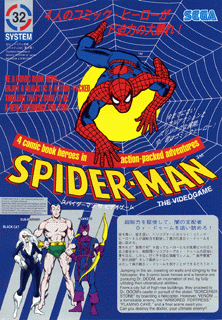Software:Spider-Man: The Video Game
| Spider-Man: The Video Game | |
|---|---|
 Japanese flyer of Spider-Man: The Video Game | |
| Developer(s) | Sega |
| Publisher(s) | Sega |
| Designer(s) | Roppyaku Tsurumi[1] |
| Composer(s) | Kazuhiko Nagai[2] |
| Platform(s) | Arcade |
| Release | September 1991[3] |
| Genre(s) | Beat 'em up |
| Mode(s) | Up to 4 players simultaneously |
| Arcade system | Sega System 32 |
Spider-Man: The Video Game, also known as Lua error in Module:Lang/utilities at line 332: attempt to call field '_transl' (a nil value).[3] is a 1991 arcade video game developed by Sega based on the Marvel Comics character Spider-Man.
Plot
Spider-Man and his allies must retrieve a mystical artifact first from the Kingpin, then Doctor Doom.
Gameplay

The game was released as a coin-operated arcade title based on the Sega System 32 hardware. The game can be played as a single player game or up to a four players cooperatively. Each character can do a special move related to their super power which reduces their health.
During levels the game changes from a side-scrolling beat 'em up into a platform game as the camera zooms to a far-away view of the characters in miniature. Later it zooms back in for the much larger and more detailed characters to continue the brawling.
The game was divided into four acts, meeting various villains, including Kingpin, Venom and his symbiote clones, Doctor Octopus, Electro, Lizard, Scorpion, Sandman, Green Goblin, Hobgoblin, and finally Doctor Doom. High scores are separated by character; so a high score on Spider-Man may not be a high score on Hawkeye or Black Cat.
Spider-Man: The Video Game's soundtrack is also partially comprised from tunes from Sega's 1986 arcade game Quartet, notably the tunes "Oki Rap" and "FM Funk" (for instance, "FM Funk" appears in the second stage in Spider-Man, while it is featured in the third stage of Quartet).
Characters
The game allows the user to play as one of four heroes: Spider-Man, Black Cat, Sub-Mariner, and Hawkeye. Unlike many games of this type which assigned a certain character to a certain joystick, any player can choose any character (as long as another player isn't already controlling them).
Each hero has a unique set of moves and attacks/abilities, which could be used to beat up the bad guys, that suited their powers and characteristics, as well as basic attacks and jumps (assigned to each of the two buttons).
Spider-Man
Spider-Man is the game's main hero and protagonist of the game. Spider-Man's move list and attacks consist primarily of moves which revolve around his web-based spider powers, such as swinging from webs and shooting webbing blasts.[4]
Black Cat
Black Cat is athletic and acrobatic like a cat, using a combination of her claws, grappling hook and cables to defeat enemies throughout the game.[5]
Hawkeye
Recognizable as one of the Avengers, Hawkeye's attacks and abilities revolve around the use of his bow and arrows in order to defeat his enemies.[4]
Sub-Mariner
A citizen of Atlantis, Sub-Mariner uses water based projectile attacks, such as a hydro-electric blast, in order to help him defeat his enemies.[5]
Development
Spider-Man: The Video Game was showcased at the 1991 Las Vegas Amusement Expo.[6][7]
Reception
In Japan, Game Machine listed Spider-Man on their November 1, 1991 issue as being the fourteenth most-successful table arcade unit of the month.[8] In the United States, it was the top-grossing new video game on the RePlay arcade charts in November 1991.[9] In Australia, it was the top-grossing arcade conversion kit on the Timezone charts in November 1991.[10]
The November 1991 issue of Sinclair User gave it the shared award for "Games Most Likely To Save The Universe" as one of the best superhero games, along with Captain America and The Avengers and Captain Commando.[7]
The game was reviewed in 1992 in Dragon #177 by Hartley, Patricia, and Kirk Lesser in "The Role of Computers" column. The reviewers gave the game 5 out of 5 stars.[11]
The January 1992 issue of Computer and Video Games gave it a positive review, praising the four-player gameplay, the "incredible graphics" with "huge, beautifully animated sprites and an impressive zoom in/zoom out effect" and the "16 different stages" with "enough to keep you pumping in the credits".[12]
See also
- List of Spider-Man video games
Notes
References
- ↑ https://x.com/tsurumy/status/1695091905229668667
- ↑ "Spider man the video game :Sega arcade1991: DEMO Tape". https://www.youtube.com/watch?v=9Q4TQI6Gp5A.
- ↑ 3.0 3.1 "SPIDER MAN". Agency for Cultural Affairs. https://mediaarts-db.bunka.go.jp/id/M732631.
- ↑ 4.0 4.1 "Spider-Man: The Videogame (Game)". http://www.giantbomb.com/spider-man-the-videogame/3030-22627/.
- ↑ 5.0 5.1 "Spider-Man the Videogame - Videogame by Sega". http://www.arcade-museum.com/game_detail.php?game_id=9717.
- ↑ Cook, John (November 1991). "Arcades: Sega". The One (emap Images) (38): 94-95. https://archive.org/details/theone-magazine-38.
- ↑ 7.0 7.1 "Coin Ops - Games Most Likely To Save The Universe". Sinclair User: 62–63. November 1991. https://archive.org/details/sinclair-user-magazine-117/page/n61.
- ↑ "Game Machine's Best Hit Games 25 - テーブル型TVゲーム機 (Table Videos)". Game Machine (Amusement Press, Inc.) (414): 25. 1 November 1991.
- ↑ "RePlay: The Players' Choice". RePlay 17 (2): 4. November 1991. https://archive.org/details/re-play-volume-17-issue-no.-2-november-1991-600dpi/RePlay%20-%20Volume%2017%2C%20Issue%20No.%202%20-%20November%201991/page/4.
- ↑ "Test Reports". Leisure Line (Australia: Leisure & Allied Industries): 20. November 1991. https://archive.org/details/Leisure_Line_1991-11_Leisure_Allied_Industries_AU/page/n19.
- ↑ Lesser, Hartley; Lesser, Patricia; Lesser, Kirk (January 1992). "The Role of Computers". Dragon (177): 57–66.
- ↑ Rignall, Julian (January 1992). "Arcade Action: Spider-Man: The Video Game Review". Computer and Video Games. http://www.solvalou.com/subpage/arcade_reviews/211/324/spiderman_review.html.
External links
 |

